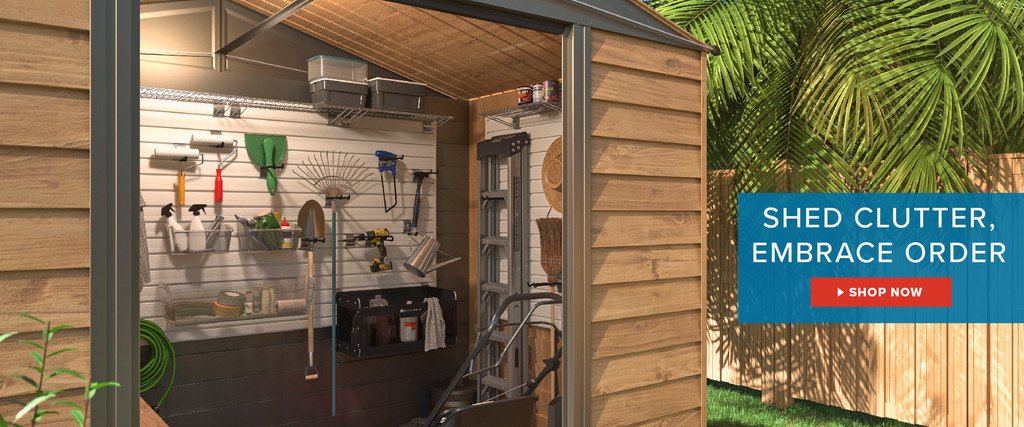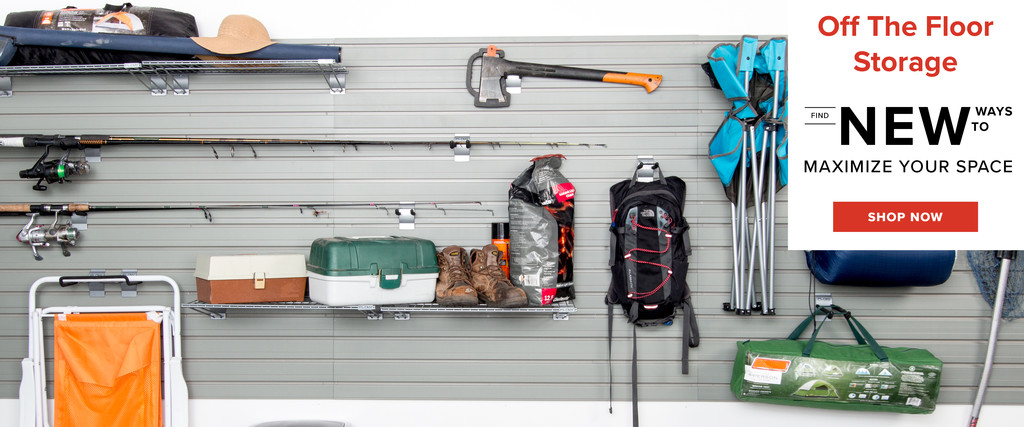A complete emergency preparedness kit is essential to every household, but many Americans face the problem of having nowhere to store their items. Properly storing your stash of emergency supplies is nearly as important as having it in the first place. If kept improperly, items can easily become damaged and unsalvageable, proving useless in the event of an emergency. Learn how to build your family emergency preparedness kit to perfection and how to store it properly with the home storage solutions in this article.
What To Include In Your Home Emergency Preparedness Kit
Below, we have included a list of essentials that should be included in your home emergency preparedness supplies. If you would like to expand your storage beyond the basics, you can start with the list of items recommended by the Department of Homeland Security.
- At least 3-day's worth of food and water for each person in the household
- Battery-powered radio
- Flashlights and plenty of extra batteries
- An extensive first aid kit
- Garbage bags, moist towelettes, and plastic ties
- Basic tools
- Can opener
- Mobile phone, phone charger, and a wireless charger
Emergency Preparedness Storage Tips
Once you've compiled your collection of emergency preparedness supplies, it's important to store and maintain items properly. Use these emergency preparedness storage tips to maintain the longevity of every item in your kit.
- Store canned food in a cool, dry place and boxed food in metal or airtight containers
- Regularly check for expired foods to remove and replace them
- Keep food off the floor to protect from rodents, insects, flooding, etc.
- If you live in an extremely humid climate, consider climate-controlled home storage solutions
- Store non-food items in airtight bags
- Keep a portable emergency preparedness kit in duffle bags or containers that will be easy to transport
- Keep items organized for quick and convenient access in case of emergency
Home Storage Solutions for Emergency Preparedness Supplies
When it comes to preserving your stash of emergency preparedness supplies, there are plenty of ways you can do it. Some homeowners keep their stash in their kitchen pantry, but this takes up a lot of room and limits how much can be stored for emergencies. Others choose to store their emergency kits in the basement or cellar (if they have one) which is a great place because it stays cool; however, by storing your emergency items in the basement, you run the risk of a flood damaging your supplies. The garage makes for a fantastic place to store emergency kits because it's out of the way and protected from the elements. Build the perfect emergency preparedness collection and store it properly with these garage storage solutions.
All-in-One Deluxe Garage Storage
Investing in some heavy-duty deluxe garage storage is the best way to preserve your emergency preparedness supplies for years to come. These home storage solution systems are designed for off-the-ground installation and provide a myriad of cabinets, drawers, and shelving options for you to store your items effectively. The great thing about a deluxe garage storage unit is that you can store your entire collection comfortably in one place with enough room for it to grow as the years go by.
Home Emergency Preparedness Supplies [Storage Solutions & Tips]
No one really expects to be hit by a natural disaster or another emergency scenario—yet this is a reality for millions of Americans who are faced with the possibility of tornadoes, hurricanes, floods, wildfires, and other disasters across the country. So, how do you prepare for an emergency?
How Do You Prepare for an Emergency?
It’s easy to get overwhelmed by all the things you could do to prepare for an emergency. So rather than become paralyzed by the many options, it’s best to start simple. Here are three important and actionable steps to help you be more prepared for any emergency:
Make a communication plan. In a real emergency, you may not be able to reach family members via text or a phone call. Discuss different scenarios with the people you live with and make sure you have a sure-fire way of communicating with loved ones in an emergency. Think: designating a meeting place, creating an emergency contact list, etc.
Create an evacuation plan. There are many emergency situations where you may only have a few minutes to get out of your home. For this reason, it’s important to have an evacuation plan in place so you can execute it as calmly as possible if the need arises. Don’t forget to consider all possible routes you could take to safely exit the house and think about any special needs that family members may have.
Create an emergency kit. Another key step to preparing for an emergency is to have an emergency kit ready to go when you leave the house or when you’re traveling in your car. Be sure to include everything to cover essential needs for at least 72 hours, including water, blankets, food, first-aid supplies, medications, etc.
Where Is the Best Place to Store an Emergency Kit?
You have your emergency kit packed and ready to go. But unfortunately, your kit won’t do you any good if you only have a few moments to grab it—and you don’t have it stored in an accessible location. So, where is the best place to store an emergency kit?
Ideally, you would store a few emergency kits in different locations so you are prepared for any scenario. Here are some of the best places to keep your kit when you need to leave in a hurry:
Under the bed
Garage
Storage closet (near an exit)
Car
Storage unit
Basement
Spare room
Shed
Cabin or second home
No matter where you decide to store your emergency kit, remember to keep it out of direct sunlight to avoid spoiling your supplies. Write down expiration dates and try to choose a pest-free, climate-controlled location to ensure your supplies last as long as possible.
How Do I Organize My Emergency Food Supply?
Keeping your emergency food supplies organized will ensure they’re accessible and ready to go when you actually need to use them. And how do you organize your emergency food supply? Here are a few ideas:
Group similar items together, such as canned vegetables and fruits, oats and dry goods, dehydrated meals, water, etc.
Make sure the oldest items are stored in the front, so you can use them before they expire (and then replace them with new food).
Store items on a shelf and out of direct sunlight to keep them from spoiling.
Store some lightweight emergency food items in your emergency kit or bug bag.
Consider sorting food storage according to the needs of each family member, i.e., baby food and kid-friendly food in one area and food to meet special dietary needs in another area.
Keep inventory of your food and check it off as you use it.
How Will You Maintain Your Emergency Kit?
You may be patting yourself on the back for putting together an emergency kit—but the work isn’t over yet. Now you need to make sure to maintain your emergency kit so all of the items are ready for use as needed.
How will you maintain your emergency kit? Follow these tips:
Store your kit out of direct sunlight, ideally in a cool, dry, climate-controlled room.
Check your emergency kit every six months to use and then replace items that will expire soon.
Reevaluate your kit every year to determine if there are things you should add or take away.
Replenish supplies as you use them.
Store food and water in air-tight containers.
Make sure batteries are replaced every 3-5 years.
Build Your Own
If the deluxe garage storage system isn't for you, then you can assemble your own emergency preparedness storage with the right pieces. Pick a combination of garage organization solutions that will work best for you and your emergency stash, from cabinet sets to shelving. We recommend you get an enclosed storage space for your food items and make sure to keep everything elevated above ground. If you're low on space, you can also utilize ceiling storage. By using the tips above you'll be on your way to more organized storage of your emergency preparedness supplies. Good luck with creating and storing your family emergency preparedness supplies.


![Home Emergency Preparedness Supplies [Storage Solutions & Tips]](/core/media/media.nl?id=2938974&c=1259219&h=s-cBHJHJpButlNYKRbHrmU3_h8tx5x1KajItA1iiFSisWCMo&resizeid=126&resizeh=1024&resizew=1024)


